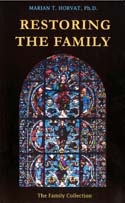 |
What People Are Asking
Catholic Teaching on Monarchy and Democracy
 |
Dear Marian Horvat,
I wonder if you could suggest to me one or two good history text books for children which tell history the way it is (i.e. from the Catholic viewpoint)?
My wife and I recently started home-schooling our children and as part of our history teaching material we obtained a copy of an American Catholic school history textbook (originally published in 1937) from a traditional home school book supplier in the United States. I thought that the book, entitled, The Old World and America by Rev. PJ Furlong, given its pre-Vatican II imprimatur, would be ‘safe’ to use with our children. In many respects the book seems fine but I was alarmed to read that of the three types of government described in the Greek history section: Monarchy, Aristocracy and Democracy; ‘the ideal form of government is that kind in which the people rule themselves (i.e., democracy)’.
I wonder if promotion of democracy in this book was an example of the Americanism I’ve read about – based upon freemasonic principles – creeping into Catholic education in the early part of the twentieth century.
Although we are fairly new to Traditional, and I am by no means an expert, I have done some reading in this area and my understanding now is that the ‘ideal’ form of government is probably monarchical if its ruling principles are guided by the teachings of the Church, i.e., the Reign of Christ the King.
Two questions:
- I am right to think this?
- And, can you recommend to us good books to teach our children a proper understanding of history? My children’s ages are 8 weeks, 2, 4, 6, 7, 9 and 11 years old.
Thank you for all your clear advice and scholarly articles on rearing Catholic children and about restoring a truly Catholic culture to the Catholic home – they have been most valuable to my wife and I as we struggle to sift the wheat from the chaff. Well done!
Yours sincerely and with our prayers,
G.K.

Dr. Horvat responds:
Dear Mr. and Mrs. G.K.,
Thank you for your kind words on my articles.
Regarding your first question, certainly St. Thomas teaches that “all should take some share in the government, for this form of constitution ensures peace among the people (Summa Theologiae, I.II. q. 105, answer). But this does not imply that ‘the ideal form of government is that kind in which the people rule themselves (i.e., democracy)’ as you quoted Bishop PJ Furlong stating in his history textbook.
On the contrary, in the same place St. Thomas teaches that “the kingdom [or monarchy] is the best form of government as long as it is not corrupt” (answer to the 2nd objection). The next best form of government is aristocracy, understood as the government by the best, and finally democracy, the government by the people. These are the three forms of government approved by Catholic doctrine in the order of preference. However, the best form at all, according to St. Thomas, is a blend of the three, taking into consideration the needs and the circumstances of each people. In all these forms of government there is a proportionate share of the power by the people through different processes.
The same doctrine can be found in the encyclicals Au milieu des solicitudes and Diuturnum by Leo XIII, among many other teachings of the Church on the topic.
Notwithstanding this clear doctrine, it is not surprising to find old American Catholic history books championing the revolutionary principles of the Enlightenment that inspired our modern democracies. Famous Catholic historians like John Gilmary Shea (1824-1892) and Theodore Maynard (1880-1956) bent over backwards in their histories to pretend that there are no clashes between Catholicism and the revolutionary principles of modern democracies.
Maynard tries to justify the support liberal Catholics gave to the American Revolution with these words:
"They did so because the principles of the Revolution were so closely consonant with Catholic political philosophy" (The Story of American Catholicism, p.117).
John Shea went so far as to pretend that all Catholics in Colonial American supported the revolution, that none were Tories, or monarchists (The History of the Catholic Church in America, Vol. I). This is not true. Many Catholics supported the monarchy.
This type of history pretends to demonstrate that monarchy is against Catholicism, It is the Catholic liberal history that filtered into Catholic history books in parochial schools.
These liberal Catholics promote some of the errors condemned by Pope Leo XIII under the name of Americanism in 1889, as you suspected.
Regarding your second question, which asks for good books to teach your children a proper understanding of history, what I can advise is limited:
A good history book that presents a Catholic view of world history is Christ the King: Lord of History by Anne Carroll. Its primary audience is grades 6-8.
My answer is meager, I know, but these are the few sources I have at present. I would like to have more time to research better texts that may have been published, but time is a commodity I lack right now.
Sincerely,
Marian T. Horvat, Ph.D.

Posted January 12, 2007

Related Topics of Interest
 History from a Counter-Revolutionary Perspective History from a Counter-Revolutionary Perspective
 Co-Education is a False and Harmful Method of Teaching Co-Education is a False and Harmful Method of Teaching
 Crisis in Catholic Education and St. Thomas' Solution Crisis in Catholic Education and St. Thomas' Solution
 Crisis in Catechism Crisis in Catechism
 Rules on Rhetoric Rules on Rhetoric



|
Horvat | Questions | Comments | Home | Books | CDs | Search | Contact Us | Donate

© 2002-
Tradition in Action, Inc. All Rights Reserved
|
 |
|